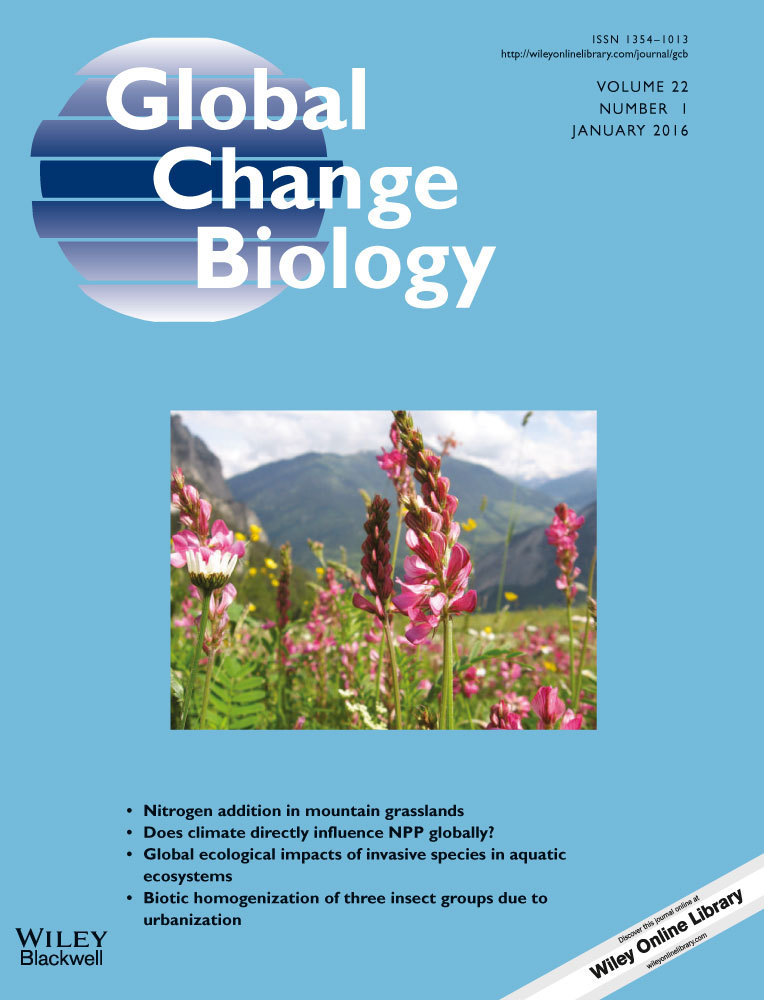Beyond just sea-level rise: considering macroclimatic drivers within coastal wetland vulnerability assessments to climate change
Abstract
Due to their position at the land-sea interface, coastal wetlands are vulnerable to many aspects of climate change. However, climate change vulnerability assessments for coastal wetlands generally focus solely on sea-level rise without considering the effects of other facets of climate change. Across the globe and in all ecosystems, macroclimatic drivers (e.g., temperature and rainfall regimes) greatly influence ecosystem structure and function. Macroclimatic drivers have been the focus of climate change-related threat evaluations for terrestrial ecosystems, but largely ignored for coastal wetlands. In some coastal wetlands, changing macroclimatic conditions are expected to result in foundation plant species replacement, which would affect the supply of certain ecosystem goods and services and could affect ecosystem resilience. As examples, we highlight several ecological transition zones where small changes in macroclimatic conditions would result in comparatively large changes in coastal wetland ecosystem structure and function. Our intent in this communication is not to minimize the importance of sea-level rise. Rather, our overarching aim is to illustrate the need to also consider macroclimatic drivers within vulnerability assessments for coastal wetlands.
Introduction
Incorporating the effects of climate change into current conservation efforts is an increasingly critical challenge for ecologists and natural resource managers. The development of climate-smart conservation practices (sensu Stein et al., 2014) depends heavily upon information obtained from climate change vulnerability assessments, which are comprised of the following three components: (1) sensitivity to climate change; (2) exposure to climate change; and (3) adaptive capacity in response to climate change (Glick et al., 2011). Scientists use vulnerability assessments to better understand, predict, and communicate the potential effects of climate change. Organizations that manage natural resources (e.g., federal and local governmental agencies, nonprofits) increasingly use results from climate change vulnerability assessments to develop long-term climate change adaptation plans. Throughout this document, we refer to vulnerability assessments in the broadest sense. Hence, our comments apply both to organization-led vulnerability assessments as well as future-focused peer-reviewed studies and models that could be considered vulnerability assessments.
Optimally, climate change vulnerability assessments consider the effects of multiple interacting components of climate change and identify those aspects of climate change which are most likely to affect future conservation outcomes. However, in some ecosystems, vulnerability to certain abiotic drivers may seem so severe that other aspects of climate change critical for conservation planning efforts may be ignored. These single-driver vulnerability assessments run the risk of missing key interactions with other climatic drivers that could adversely affect conservation outcomes. Here we focus on coastal wetlands, where the majority of climate change research and conservation planning efforts have concentrated on the ecological implications of a single climatic driver: accelerated sea-level rise.
Moving beyond just sea-level rise
Sea-level rise is the component of climate change that will likely have the largest impact on coastal wetlands because inundation and salinity regimes are tremendously important abiotic drivers within these systems (Morris et al., 2002; Mitsch & Gosselink, 2007; Perillo et al., 2009; Armitage et al., 2015). However, there are many other aspects of climate change that will also affect coastal wetlands (McKee et al., 2012), and some of these other factors are too important to ignore. Here we draw attention to the role of macroclimatic drivers (e.g., temperature and rainfall regimes, including the frequency of extreme events). Please note that our intent in this communication is not to minimize the importance of sea-level rise effects. Rather, our aim is to highlight the need to also consider the potential effects of macroclimatic drivers.
Although macroclimatic drivers greatly influence the structure and functioning of all of earth's ecosyst-ems (Holdridge, 1967; Whittaker, 1970), macroclimatic drivers are rarely incorporated into vulnerability assessments for coastal wetlands. Globally, the number of sea-level rise focused vulnerability assessments for coastal wetlands surpasses triple digits and that number has been increasing rapidly in recent years; however, most of these vulnerability assessments do not directly consider the effects of changing macroclimatic conditions.
Similar trends are observed within the published peer-reviewed literature and for citations within peer-reviewed research (Fig. 1a, b, respectively). Between 1980 and 2014, the number of published articles that examined the potential effects of climate change-induced sea-level rise in coastal wetlands was greater than the number of published articles that examined the implications of changing temperature regimes and/or changes in rainfall or aridity (100, 16, and 36 articles, respectively; Fig. 1a). Citations during that period reflected the same pattern (Fig. 1b). The limited amount of macroclimate-focused research in coastal wetlands contrasts with research from noncoastal terrestrial ecosystems, where macroclimatic drivers are often the primary climate change drivers included in climate change vulnerability assessments.
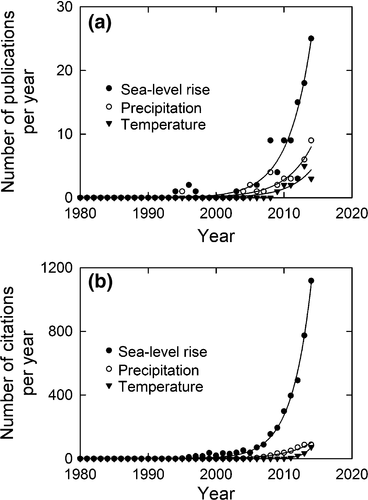
In this communication, our objectives are to: (1) highlight the importance of temperature and rainfall regimes as factors that control ecosystem structure and function in coastal wetlands, (2) show that there are some coastal transition zones where the ecological effects of changing macroclimatic drivers are especially important, and (3) illustrate the need to incorporate macroclimatic drivers into climate change vulnerability assessments for coastal wetlands.
Macroclimatic controls upon foundation plant species in coastal wetlands
From a functional perspective, the ecological effects of climate change are likely to be especially large in ecosystems that are disproportionately dependent upon a single or small number of foundation species (Didham et al., 2005; Osland et al., 2013). Foundation species are species that create habitat, modulate ecosystem processes, and support entire ecological communities (Dayton, 1972; Bruno & Bertness, 2001; Ellison et al., 2005; Angelini et al., 2011). The functional importance of foundation species is greatest in ecosystems where intense and dynamic abiotic conditions limit the number of species that can survive and become dominant (e.g., kelp beds, salt marshes, mangrove forests, dryland ecosystems). In these demanding environments, ecosystem structure and function is greatly influenced by a single or small number of foundation species. As a result, small changes in key abiotic factors that alter the performance, or even cause the loss, of a foundation species can have comparatively large effects upon ecosystem structure and function. Foundation species replacement or loss can affect ecological resilience and qthe supply of some ecosystem goods and services (Ellison et al., 2005; Osland et al., 2013).
In coastal wetlands, foundation plant species play an important functional role and their abundance and performance is greatly influenced by macroclimatic drivers (Figs 2 and 3) (Saenger, 2002; Alongi, 2015; Lovelock et al., In press). In hot and wet climatic zones (i.e., the ‘wet’ tropics and subtropics), woody plants are often dominant and produce mangrove forest ecosystems (Tomlinson, 1986; Alongi, 2009; Twilley & Day, 2012). In cool and wet climatic zones (i.e., ‘wet’ temperate and arctic climes), graminoid-dominated salt marshes are most abundant (Adam, 1990; Pennings & Bertness, 2001). In dry climatic zones (i.e., arid and semi-arid climates), succulent plant-dominated salt marshes are common and hypersaline conditions can produce algal mat-covered tidal flats (Zedler, 1982; Ridd et al., 1988; Adam, 1990). Despite a qualitative understanding of the important effects of macroclimate upon coastal wetland ecosystems, the influence of interactions between macroclimatic drivers (e.g., rainfall and temperature regimes) upon ecosystem composition, structure, and function has not been fully elucidated. In Fig. 2, we illustrate this gap in our knowledge, as well as the large differences in ecosystem structure and function between these coastal wetland habitats, with photographs of distinct macroclimate-influenced coastal wetland ecosystems. The positions of the ecosystems in macroclimatic space can be used to coarsely envision the ecological transitions that can be triggered by altered macroclimatic conditions. The question mark is included in the figure to highlight the need to better quantify the interactive influence of macroclimatic drivers upon coastal wetland ecosystem structure and function.
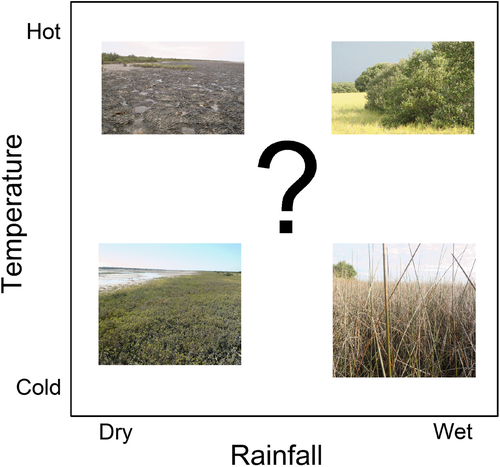
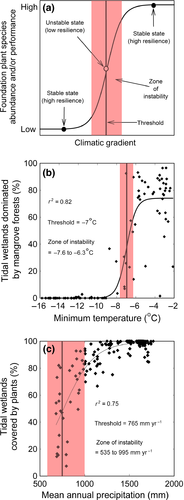
Macroclimatic thresholds and zones of instability for coastal wetlands
Across the globe and within all ecosystems, ecological transitions occur across climatic gradients (Holdridge, 1967; Whittaker, 1970). However, in physiologically demanding ecosystems, like coastal wetlands, these transitions have the potential to occur more rapidly and in a nonlinear fashion. In coastal wetlands, abrupt ecological transitions across abiotic gradients are abundant. These transitions are generally located in areas where small differences in abiotic conditions result in comparatively large differences in ecosystem structure and function. For example, if near a critical threshold, a few centimeters of elevation change within a salt marsh can result in species composition change. At the regional level, ecological transitions across macroclimatic gradients can be abrupt and, in some cases, constitute macroclimatic thresholds. Macroclimatic ecological thresholds can be defined mathematically as climatic-based areas of maximum rate of ecological change (Osland et al., 2014). These are areas of comparatively abrupt climate-driven changes in ecological structure and function (see illustration in Fig. 3a). Here we also refer to these transition areas as zones of instability.
Zones of instability are coastal reaches where small changes in macroclimatic conditions can trigger comparatively large and abrupt changes in ecosystem structure and function (see illustration in Fig. 3a, which focuses on foundation plant species abundance and performance). Ecological resilience is expected to be lower within these zones of instability (Fig. 3a), and these zones of instability separate ‘stable state’ zones which are more resilient to changing macroclimatic conditions. Here, we are using the term resilience to refer to the ability of the ecosystem to maintain ecosystem structure despite alterations in macroclimatic conditions (citations for definition: Holling, 1973; Gunderson, 2000). Within the last decade, improved quality and access to landscape-level climate and coastal wetland data have increased our ability to quantify links between climate and coastal wetland ecosystem structure (e.g., Fig. 3b, c). For coastal wetlands, macroclimate-driven ecological transitions are especially abrupt across: (1) winter air temperature gradients (Fig. 3b) within subtropical coastal zones (Osland et al., 2013; Cavanaugh et al., 2014, 2015); and (2) freshwater availability gradients within freshwater-limited coastal zones (Fig. 3c) (Bucher & Saenger, 1994; Montagna et al., 2007; Osland et al., 2014).
Along subtropical coastlines, winter air temperatures strongly determine the abundance of mangrove forests relative to salt marshes (Fig. 3b). In drier coastal reaches that span rainfall gradients, rainfall and freshwater availability determine the abundance of coastal wetland plants (Fig. 3c). Climate-coastal wetland linkages across both of these gradients are nonlinear, and because coastal wetlands are replete with positive feedbacks (sensu Wilson & Agnew, 1992), alternative stable states (sensu Holling, 1973; Beisner et al., 2003; Scheffer & Carpenter, 2003) are often present. Feedback mechanisms in coastal wetlands are diverse and qoften involve plant–soil–microclimate interactions (Bertness & Leonard, 1997; D'Odorico et al., 2013; Moffett et al., 2015; Saintilan & Rogers, 2015; Jiang et al., 2015). For example, increases in water depth and inundation frequency can lead to increased plant growth which can, in turn, increase sedimentation rates and enable some wetlands to better keep pace with sea-level rise and avoid conversion to open water q(Morris et al., 2002). Another example comes from the freeze-sensitive marsh-mangrove transition zone where black mangrove (Avicennia germinans) damage and recovery from freezing temperatures is life-stage dependent; tall black mangrove trees are more resistant and resilient to winter climate extremes than short mangrove trees (Osland et al., 2015). Hence, reductions in the frequency and intensity of freeze events are expected to enable black mangrove forest growth and expansion which would enhance resistance and resilience to future winter climate extremes. This feedback mechanism could accelerate the rate of mangrove expansion into salt marsh under climate change. Positive feedbacks are also often present in high-salinity salt marsh zones, where vegetation can ameliorate stressful edaphic conditions (e.g., hypersalinity), enhance plant growth, and lead to positive biotic interactions (Bertness, 1991; Srivastava & Jefferies, 1996; Pennings & Bertness, 1999). We expect that similar plant–soil–microclimate positive feedbacks play an important role in arid and semi-arid coastal wetlands where hypersaline soils and unvegetated–vegetated transitions zones are particularly common.
In Fig. 4a, b, we use traditional two-dimensional ball-in-cup diagrams to heuristically illustrate potential alternative stable states associated with the two highlighted macroclimatic gradients. In these diagrams, the balls are used to represent the ecosystem, zones of instability are represented by the peaks, and stable areas are represented by the valleys. Whereas the ball can be easily pushed downhill to the valleys, the ball cannot be easily pushed from the valleys upslope to the peaks. Although these diagrams are two dimensional, the interactions between temperature and rainfall could potentially be illustrated in three-dimensional macroclimatic ecological space.
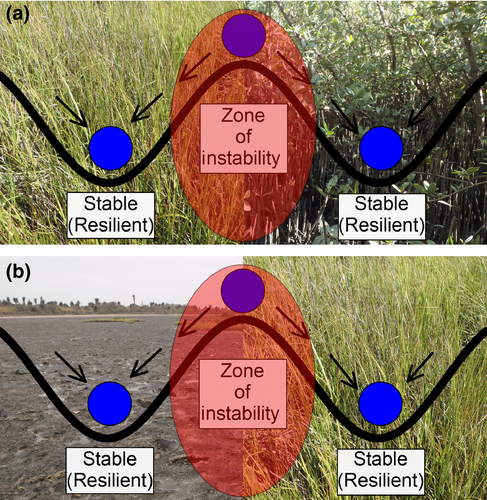
Coastal reaches in the southeastern United States where coastal wetland vulnerability to macroclimatic change is high
The southeastern United States is an excellent place to illustrate the global importance of macroclimatic controls upon coastal wetland ecosystems. Coastal wetlands are abundant in this region; approximately eighty percent of the coastal wetlands in the contiguous United States are located in the southeastern portion of the country (Field et al., 1991). In addition to providing fish qand wildlife habitat, these wetlands improve water qquality, protect coastlines, maintain coastal fisheries, store carbon, and support ecotourism (Barbier et al., 2011; Engle, 2011). From a macroclimatic perspective, this region may be especially sensitive because these abundant coastal wetlands continuously span two climatic gradients (i.e., a rainfall gradient and a winter severity gradient) that greatly influence coastal wetland ecosystem structure and function (Montagna et al., 2011; Osland et al., 2013, 2014) and the supply of ecosystem goods and services.
Recent analyses indicate that in the southeastern United States, a zone of instability exists in coastal reaches that have multi-decadal minimum air temperatures between −7.6 and −6.3 °C (i.e., the zone in red in Fig. 3b) (Osland et al., 2013). Within this zone, which is present in Texas, Louisiana, and Florida, tidal saline wetlands contain a combination of mangrove forests and salt marshes whose relative abundance oscillates in response to the frequency and intensity of extreme winter events (i.e., freezing air temperatures). In warmer areas, mangrove forests are dominant. In colder areas, salt marshes are dominant. Since the most recent major freeze event in 1989, mangroves in all three of these states have been expanding at the expense of salt marsh (Stevens et al., 2006; Giri et al., 2011a; Montagna et al., 2011; Armitage et al., 2015). In the future, mangrove poleward expansion is expected in response to decreases in the frequency and intensity of freeze events.
Within the region, a rainfall-driven zone of instability is located in south and central Texas. The coast of Texas spans a mean annual rainfall gradient that ranges from ~650 mm yr−1 (near the Texas–Mexico border) to ~1500 mm yr−1 (near the Texas–Louisiana border). Across this rainfall gradient, the variation in composition and structure of coastal wetland plants is high (Longley, 1995; Montagna et al., 2007; Rasser et al., 2013). Recent analyses indicate that a zone of instability exists along coastal reaches where mean annual rainfall is less than ~995 mm yr−1. In these areas, small changes in freshwater availability are expected to result in comparatively large changes in the coverage of coastal wetland plants (i.e., the zone in red in Fig. 3c) (Osland et al., 2014). In contrast, wetland coverage is comparatively stable in coastal reaches with mean annual rainfall above ~995 mm yr−1.
We highlight these ecological transition zones in the southeastern United States to underscore the important role of macroclimatic controls upon coastal wetlands. Although the analyses and diagrams shown in Figs 3 and 4 illustrate the independent and highly simplified effects of temperature and rainfall, temperature and rainfall regimes interactively determine coastal wetland ecosystem structure and function (Lugo & Patterson-Zucca, 1977; Saenger, 2002; Lovelock et al., In press). Research is needed to better quantify these interactive effects within the southeastern United States and also across the globe so that they can be incorporated into vulnerability assessments.
As mentioned in the introduction, vulnerability assessments can be conceptually divided into the following three elements: (1) sensitivity, (2) exposure, and (3) adaptive capacity (Glick et al., 2011). At regional and global scales, the adaptive capacity of coastal wetlands is high; coastal wetlands have adapted to past fluctuations in sea level and climatic conditions via horizontal and vertical movement on the landscape (Alongi, 2015). Along with climate change projections (i.e., exposure), Osland et al. (2013, 2014) used the sensitivity analyses illustrated in Fig. 3b, c, respectively, to evaluate coastal wetland vulnerability to macroclimatic change in the southeastern United States. Those results have been adapted in Fig. 5 to illustrate: (1) coastal reaches that are vulnerable to mangrove expansion into salt marsh due to changes in winter temperature extremes (areas denoted by red ovals in Fig. 5; adapted from Osland et al., 2013); and (2) coastal reaches where changing rainfall regimes could lead to changes in the coverage of foundation plant species within coastal wetlands (area denoted by the blue oval in Fig. 5; adapted from Osland et al., 2014).
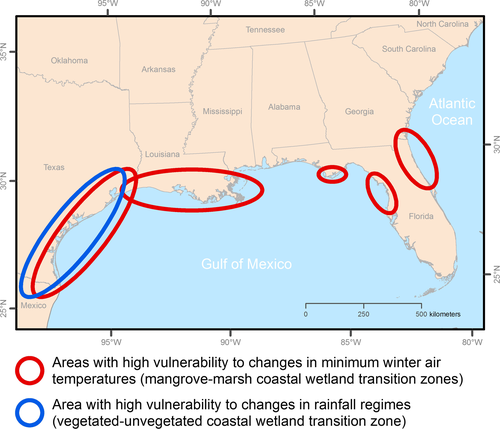
These areas merit close attention and additional research and monitoring. Within these zones, we recommend that historical and current climate-coastal wetland linkages should be studied more intensively so that we can better understand, anticipate, and prepare for the effects of changing macroclimatic conditions. We also recommend that, within these zones, coastal wetland management and restoration efforts should consider and prepare for the effects of future changes in macroclimatic conditions. For example, land–ocean temperature gradients are common across the northern Gulf of Mexico. These gradients can be used to identify hot spots of mangrove expansion and also identify areas of salt marsh that are least likely to be converted to mangrove. Such information could be used to inform planting guidelines at restoration sites as well as manage for areas that may serve as climate refugia for specific fish and wildlife species that use marsh or mangrove vegetation, respectively. Within drier coastal zones, an ecological flows perspective could be used to alter the quantity and timing of freshwater inputs to estuaries in order to offset expected changes to plant communities due to limited rainfall and hypersaline conditions.
Despite the potential for macroclimate-induced regime shifts within coastal wetlands of the southeastern United States, coastal wetland vulnerability assessments in the region have focused primarily on sea-level rise and have not explicitly incorporated macroclimatic drivers. Texas, Louisiana, and Florida are all states where changing temperature and/or rainfall regimes have the potential to lead to regime shifts in coastal wetlands (e.g., mangrove replacement of salt marsh or salt flat replacement of salt marsh). However, coastal wetland vulnerability assessments conducted in these states typically do not incorporate macroclimatic drivers. Governmental agencies (state and federal) and nonprofit organizations working in these states have developed long-term adaptation and restoration plans for coastal wetlands; however, these plans are based upon coastal wetland vulnerability assessments that solely evaluate the effects of sea-level rise and do not incorporate the effects of macroclimatic drivers. Moreover, coastal wetland scientists working in these states routinely develop future-focused sea-level rise models that predict coastal wetland vegetation change but do not account for the influence of macroclimatic drivers. We recommend that coastal wetland vulnerability assessments within these zones of instability (e.g., Texas, Louisiana, and parts of Florida) incorporate macroclimatic drivers.
Coastlines across the globe where wetland sensitivity to macroclimatic change is high
Macroclimatic gradients similar to those present in the southeastern United States can be found on many continents. For example, winter climate gradients that affect mangrove–marsh–salt flat interactions are also present in Australia, New Zealand, South America, western North America, southeastern Africa, the Middle East, and Asia (Saenger, 2002; McKee et al., 2012; Quisthoudt et al., 2012; Record et al., 2013; Saintilan et al., 2014; Alongi, 2015; Lovelock et al., In press). Further, Western Australia, the Middle East, western Mexico, western Africa, and western South America all contain coastal reaches where rainfall and freshwater inputs limit the coverage of coastal wetland plants (Adam, 1990; Bucher & Saenger, 1994; Semeniuk, 2013). Saenger (2002) and Saintilan et al. (2014) provide useful qualitative descriptions of each of these transition zones. In Fig. 6, we highlight areas across the globe where we expect abrupt ecological transitions in coastal wetlands to occur across macroclimatic gradients. We identify (1) mangrove–marsh transition areas where winter air temperatures regulate the relative abundance of these two functional groups; (2) freshwater-limited coastlines where hypersaline conditions are likely present and freshwater inputs govern the relative abundance of vegetated and unvegetated wetlands; and (3) areas where these two climatic gradients overlap.
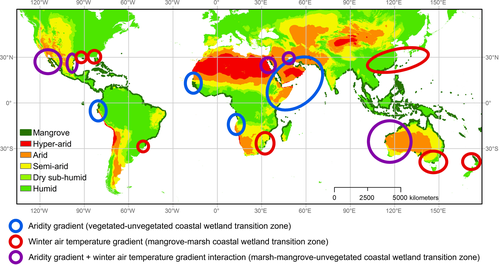
Please note that the thresholds identified for the southeastern United States (i.e., those thresholds identified in Fig. 3b, c) are likely different in other parts of the world due partly to different climatic conditions and physiological adaptations. For example, in some poleward mangrove–marsh ecotones (e.g., Australia, New Zealand), extreme freeze events play a less important role than in the United States (Stuart et al., 2007; Lovelock et al., In press). In such areas, the temperature-based threshold would be quite different than the one identified in Fig. 3b. Similarly, we expect that the precipitation-based threshold would be different in other parts of the world. For example, the threshold for an area with a seasonal wet–dry climate (i.e., an extended dry season) would likely be different than for an area where rainfall is evenly distributed throughout the year; hypersaline conditions are more likely to develop in the wet–dry climate which could lead to lower vegetation coverage despite high rainfall during the wet season (Fosberg, 1961). Moreover, interactions between rainfall and temperature regimes would also alter these thresholds (Lugo & Patterson-Zucca, 1977; Quisthoudt et al., 2012).
The effects of changing macroclimatic conditions upon ecosystems and the services they provide
What are the implications of macroclimate-induced regime shifts for ecosystem structure and function? What are the implications for the goods and services that coastal wetlands provide? These are important questions, and ones that we suspect scientists will be examining for many decades to come. All coastal wetlands provide important goods and services, and we expect that regime shifts will be accompanied by trade-offs in ecosystem goods and services; certain regime shifts may result in the increase of certain goods and services while resulting in a decrease in other goods and services. We also expect that the ecological implications of coastal wetland regime shifts will be highly location-dependent. We provide some examples from existing studies, but there is still much work to be accomplished in this arena.
The ability of wetlands to keep pace with sea-level rise is, in many cases, dependent upon positive feedbacks between inundation and plant growth (Morris et al., 2002; Kirwan & Megonigal, 2013; Krauss et al., 2014). How do different plant functional groups affect these positive feedbacks and the ability of coastal wetlands to adjust to rising seas? How can these effects be incorporated into predictive models of coastal wetland responses to sea-level rise? These are pressing questions that merit attention and highlight the importance of considering macroclimatic drivers within future-focused models and vulnerability assessments. Mangroves, salt marshes, and algal mat-dominated tidal flats are all highly productive systems with the capacity to keep pace with sea-level rise in some situations, but how might they differ in their ability to adjust to future inundation regimes in order to maintain their current position in the landscape?
For example, in parts of Louisiana, high rates of relative sea-level rise have resulted in the conversion of salt marsh to open water (i.e., coastal wetland loss) (Couvillion et al., 2011). Meanwhile, black mangroves (A. germinans) have been expanding in some of these marshes since 1989. How does the transition from a Spartina alterniflora-dominated salt marsh to a mature A. germinans forest affect the ability of these coastal wetlands to adjust to inundation? Moreover, in areas where black mangroves have replaced salt marsh, is it possible that an extreme freeze event could trigger peat collapse and result in more rapid wetland loss? In contrast, what are the implications of drought-induced vegetation mortality and conversion to algal mat-dominated flats for coastal wetland vertical adjustment in dry climates? Algal mats have the potential to contribute to accretion (McKee, 2010), but how would a vegetated-to-unvegetated coastal wetland regime shift affect wetland stability?
In coastal settings with low mineral sedimentation, organic matter (i.e., peat) accumulation plays an important role in the maintenance of soil elevations (McKee, 2010; Krauss et al., 2014). How might coastal wetland regime shifts affect peat development? In recent years, multiple studies have compared the above and belowground properties of salt marshes and mangrove forests within the mangrove–marsh ecotone. Mangrove expansion into salt marsh results in higher aboveground biomass and aboveground carbon stocks (Osland et al., 2012; Yando, 2014; Saintilan & Rogers, 2015; Doughty et al., 2015); however, the implications for peat accumulation, belowground carbon stocks, and soil properties are variable and location-dependent.
In terrestrial grasslands, the belowground implications of woody plant encroachment are rainfall-dependent; in areas with low rainfall, woody plant encroachment often results in higher soil organic matter concentrations (Eldridge et al., 2011), but that is not the qcase for wetter grasslands (Jackson et al., 2002; Berthrong et al., 2012). A recent study indicates that a similar rainfall-dependent pattern may be present in coastal wetlands (Yando, 2014). While studies conducted in freshwater-limited coastal reaches have found that mangrove expansion into salt marsh has resulted in higher soil organic matter concentrations and carbon stocks (Comeaux et al., 2012; Bianchi et al., 2013; Saintilan & Rogers, 2015), studies from wetter coastal reaches have found no differences in many of the soil properties present in mangrove forests compared to salt marshes (Perry & Mendelssohn, 2009; Henry & Twilley, 2013; Doughty et al., 2015). As peat development plays an important role in soil elevation change, these rainfall-dependent results could imply that there are rainfall-dependent differences in the implications of mangrove expansion into salt marsh for soil elevation change and stability in response to sea-level rise. However, experiments are needed to verify this hypothesis and better identify the processes responsible for such differences.
In addition to the implications for carbon stocks and coastal wetland stability, what are the implications of macroclimate-induced coastal wetland regime shifts for coastal food webs, biotic interactions (Guo et al., 2013), fish and wildlife habitat (Chavez-Ramirez & Wehtje, 2012; Riley et al., 2014), nutrient cycling (Henry, 2012; Lewis et al., 2014), recreation, maintenance of coastal fisheries (Caudill, 2005), and resilience to disturbances and extreme events? For some coastal communities, the implications of the resultant trade-offs in ecosystem services may be small. However, for coastal communities that prioritize a specific ecosystem good or service, the implications may be large.
A notable and particularly charismatic example can be found in central Texas, where salt marshes in and around the Aransas National Wildlife Refuge provide winter habitat for a critically endangered whooping crane population (Grus americana). This whooping crane population is the only remaining self-sustaining population in the world (Chavez-Ramirez & Wehtje, 2012). The salt marshes in this area provide food for whooping cranes and are the most important winter habitat for this population (Chavez-Ramirez, 1996). However, since 1989, mangroves in this area have been expanding at the expense of salt marsh which concerns environmental managers because mangroves are expected to negatively affect the habitat needed by cranes. If mangroves continue to expand and replace salt marsh, the winter habitat for this critically endangered population could be compromised.
‘Tropicalization’ and ‘desertification’ in coastal wetland ecosystems
In some ways, the ecological effects of altered temperature and rainfall regimes in coastal wetland ecosystems are analogous to the tropicalization and desertification processes that are occurring and predicted for some marine and terrestrial ecosystems, respectively, in response to climate change. In an ecological context, tropicalization is a term that has been most often used within marine ecosystems in reference to the poleward movement of tropical marine organisms (e.g., Bates et al., 2014; Vergés et al., 2014; Heck et al., 2015). Desertification is a term that has been most often used in terrestrial ecosystems in reference to the conversion of vegetated wetter–climate ecosystems (e.g., grasslands) to arid-like ecosystems with lower vegetation coverage (e.g., Schlesinger et al., 1990; Reynolds et al., 2007; Peters et al., 2015). Here we borrow and apply these terms to coastal wetlands in order to engage a broad audience and illustrate the conceptual linkages between climate change impacts in coastal wetland ecosystems with those expected in terrestrial and marine ecosystems. For coastal wetlands, the term ‘tropicalization’ could be applied to the poleward migration of mangrove forests at the expense of salt marshes, a process that is triggered by a reduction in the frequency and intensity of extreme winter events. With climate change, poleward mangrove expansion into salt marsh is expected on multiple continents (Osland et al., 2014; Saintilan et al., 2014). Similarly, the term desertification could be applied to the increase and expansion of hypersaline coastal wetland ecosystems common to arid and semi-arid climates (e.g., unvegetated salt flats and succulent plant-dominated marshes) at the expense of other coastal wetland types that require higher rainfall and freshwater inputs (e.g., graminoid-salt marshes and mangrove forests), a process that can be triggered by reductions in rainfall and freshwater availability (Osland et al., 2014). In terrestrial and marine ecosystems, the ecological implications of tropicalization and desertification are large. The analogous processes in coastal wetlands would also greatly affect ecosystem structure and function.
Conclusions
In this article, our aim is to demonstrate the need to consider macroclimatic drivers within vulnerability assessments for coastal wetlands. Our comments apply both to organization-led vulnerability assessments as well as future-focused peer-reviewed studies and models that could be considered vulnerability assessments. We show that for some coastal wetlands, changing macroclimatic conditions can have large ecological effects via the replacement or loss of foundation plant species and functional groups. A better understanding of the roles of macroclimatic drivers is warranted, and we recommend that, in addition to sea-level rise, vulnerability assessments and climate-smart conservation planning efforts for coastal wetlands should consider the role of macroclimatic drivers.
We hope that this communication prompts scientists and environmental planners to consider the potential effects of changing macroclimatic conditions upon the coastal wetland ecosystems that they study or manage. Although mangroves, salt marshes, and salt flats are often treated as entirely different ecosystems, there is much to gain from considering these systems together via a holistic lens. In the context of climate change, broad perspectives are needed, and scientists and environmental managers should consider the possibility that, in addition to being converted to open water or migrating vertically or horizontally in response to accelerated sea-level rise, their local wetland could be dominated by an entirely different foundation species and/or functional group in response to changing macroclimatic conditions.
Acknowledgements
We thank Chris Swarzenski, the associate editor, and three anonymous reviewers for their comments on a previous version of this manuscript. This research was supported by the U.S. Geological Survey's Ecosystems Mission Area, U.S. Geological Survey's Climate & Land Use Change R&D Program, the Department of Interior South Central Climate Science Center, the Department of Interior Southeast Climate Science Center, and the Gulf Coastal Plains and Ozarks Landscape Conservation Cooperative. This manuscript is submitted for publication with the understanding that the U.S. Government is authorized to reproduce and distribute reprints for Governmental purposes.



